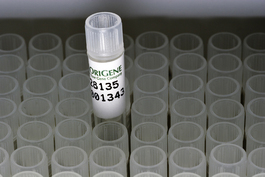Galectin 3 (LGALS3) (NM_001177388) Human Untagged Clone
CAT#: SC328315
LGALS3 (untagged)-Human lectin galactoside-binding soluble 3 (LGALS3) transcript variant 3
"NM_001177388" in other vectors (4)
Product Images

Specifications
| Product Data | |
| Type | Human Untagged Clone |
| Tag | Tag Free |
| Symbol | LGALS3 |
| Synonyms | CBP35; GAL3; GALBP; GALIG; L31; LGALS2; MAC2 |
| Vector | PCMV6-Neo |
| E. coli Selection | Ampicillin (100 ug/mL) |
| Mammalian Cell Selection | Neomycin |
| Sequence Data |
>NCBI ORF sequence for NM_001177388, the custom clone sequence may differ by one or more nucleotides
ATGGCAGACAATTTTTCGCTCCATGATGCGTTATCTGGGTCTGGAAACCCAAACCCTCAA GGATGGCCTGGCGCATGGGGGAACCAGCCTGCTGGGGCAGGGGGCTACCCAGGGGCTTCC TATCCTGGGGCCTACCCCGGGCAGGCACCCCCAGGGGCTTATCCTGGACAGGCACCTCCA GGCGCCTACCCTGGAGCACCTGGAGCTTATCCCGGAGCACCTGCACCTGGAGTCTACCCA GGGCCACCCAGCGGCCCTGGGGCCTACCCATCTTCTGGACAGCCAAGTGCCACCGGAGCC TACCCTGCCACTGGCCCCTATGGCGCCCCTGCTGGGCCACTGATTGTGCCTTATAACCTG CCTTTGCCTGGGGGAGTGGTGCCTCGCATGCTGATAACAATTCTGGGCACGGTGAAGCCC AATGCAAACAGAATTGCTTTAGATTTCCAAAGAGGGAATGATGTTGCCTTCCACTTTAAC CCACGCTTCAATGAGAACAACAGGAGAGTCATTGTTTGCACTTACATGTGTAAAGGTTTC ATGTTCACTGTGAGTGAAAATTTTTACATTCATCAATATCCCTCTTGTAAGTCATCTACT TAA |
| Restriction Sites | Please inquire |
| ACCN | NM_001177388 |
| OTI Disclaimer | Due to the inherent nature of this plasmid, standard methods to replicate additional amounts of DNA in E. coli are highly likely to result in mutations and/or rearrangements. Therefore, OriGene does not guarantee the capability to replicate this plasmid DNA. Additional amounts of DNA can be purchased from OriGene with batch-specific, full-sequence verification at a reduced cost. Please contact our customer care team at custsupport@origene.com or by calling 301.340.3188 option 3 for pricing and delivery. The molecular sequence of this clone aligns with the gene accession number as a point of reference only. However, individual transcript sequences of the same gene can differ through naturally occurring variations (e.g. polymorphisms), each with its own valid existence. This clone is substantially in agreement with the reference, but a complete review of all prevailing variants is recommended prior to use. More info |
| OTI Annotation | This TrueClone is provided through our Custom Cloning Process that includes sub-cloning into OriGene's pCMV6 vector and full sequencing to provide a non-variant match to the expected reference without frameshifts, and is delivered as lyophilized plasmid DNA. |
| Product Components | The cDNA clone is shipped in a 2-D bar-coded Matrix tube as dried plasmid DNA. The package also includes 100 pmols of both the corresponding 5' and 3' vector primers in separate vials. Every lot of primer is tested to provide clean sequencing of OriGene TrueClones. |
| Reconstitution | 1. Centrifuge at 5,000xg for 5min. 2. Carefully open the tube and add 100ul of sterile water to dissolve the DNA. 3. Close the tube and incubate for 10 minutes at room temperature. 4. Briefly vortex the tube and then do a quick spin (less than 5000xg) to concentrate the liquid at the bottom. 5. Store the suspended plasmid at -20°C. The DNA is stable for at least one year from date of shipping when stored at -20°C. |
| Reference Data | |
| RefSeq | NM_001177388.1, NP_001170859.1 |
| RefSeq Size | 744 bp |
| RefSeq ORF | 603 bp |
| Locus ID | 3958 |
| Cytogenetics | 14q22.3 |
| Protein Families | Secreted Protein |
| Gene Summary | 'This gene encodes a member of the galectin family of carbohydrate binding proteins. Members of this protein family have an affinity for beta-galactosides. The encoded protein is characterized by an N-terminal proline-rich tandem repeat domain and a single C-terminal carbohydrate recognition domain. This protein can self-associate through the N-terminal domain allowing it to bind to multivalent saccharide ligands. This protein localizes to the extracellular matrix, the cytoplasm and the nucleus. This protein plays a role in numerous cellular functions including apoptosis, innate immunity, cell adhesion and T-cell regulation. The protein exhibits antimicrobial activity against bacteria and fungi. Alternate splicing results in multiple transcript variants.[provided by RefSeq, Oct 2014]' Transcript Variant: This variant (3) uses an alternate splice site in the 3' coding region, which results in a frameshift, compared to variant 1. It encodes isoform 2, which has a shorter and distinct C-terminus, compared to isoform 1. |
Documents
| Product Manuals |
| FAQs |
Resources
Other Versions
| SKU | Description | Size | Price |
|---|---|---|---|
| RC229677 | LGALS3 (Myc-DDK-tagged)-Human lectin, galactoside-binding, soluble, 3 (LGALS3), transcript variant 3 |
USD 420.00 |
|
| RG229677 | LGALS3 (GFP-tagged) - Human lectin, galactoside-binding, soluble, 3 (LGALS3), transcript variant 3 |
USD 460.00 |
|
| RC229677L3 | Lenti-ORF clone of LGALS3 (Myc-DDK-tagged)-Human lectin, galactoside-binding, soluble, 3 (LGALS3), transcript variant 3 |
USD 620.00 |
|
| RC229677L4 | Lenti-ORF clone of LGALS3 (mGFP-tagged)-Human lectin, galactoside-binding, soluble, 3 (LGALS3), transcript variant 3 |
USD 620.00 |
{0} Product Review(s)
Be the first one to submit a review






























































































































































































































































 Germany
Germany
 Japan
Japan
 United Kingdom
United Kingdom
 China
China
